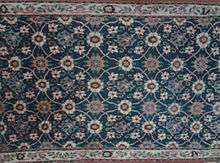Varamin carpet
Varamin carpets and rugs or Veramin carpets and rugs (Persian: قالی و فرش ورامین) are carpets and rugs woven in city of Varamin and its surrounding area which are among famous carpets in the world. Many rug and carpet experts see Varamins as being among those Persian carpets most authentic in terms of traditional style and motif.[1]
Technique and knot
The foundation is mostly made of cotton, the Persian Senneh knot is used for these rugs as opposed to the more widespread Turkish knot. Varamin is considered being among the elite of Persian carpets.[2] Veramins are made by tribal people who either live in or pass by Veramin. The principal colours used in Varamin carpets are usually dark brown and dark red on khaki or dark blue backgrounds. The village and workshop weavers mainly use the asymmetrical (Persian) knot, while the nomads, depending on their ethnicity, use either the asymmetrical or the symmetrical (Turkish) knot.[3]
Pattern and motifs
The most common design among Varamin rugs is the "Mina Khani" which is a motif composed of four round daisy-like flowers in the shape of a diamond and attached to each other by a smaller flower, repeated all over the field. Mina Khani's etymology is unknown but Mina is a feminine name.[4] Mina Khani seems to be also related to Herati motif which is more common in eastern Iran. [5]
Gallery
 A carpet with Minakhani motif
A carpet with Minakhani motif A carpet with Minakhani motif
A carpet with Minakhani motif A carpet with Zell ol Soltan motif
A carpet with Zell ol Soltan motif A carpet with Pashotori motif
A carpet with Pashotori motif
References
| Wikimedia Commons has media related to Rugs and carpets of Varamin. |
- (in English) "Varamin carpets in Little Persia". www.little-persia.com.
- "Varamin carpets and rugs". www.oriental-carpets.com.
- (in English) "Varamin rugs". www.oldcarpet.com.
- Milanesi, Enza (1999). The Carpet: Origins, Art and History. Pennsylvania State University: Firefly Books. p. 35. ISBN 9781552094389.
- Ford, P. R. J. (1989). The oriental carpet: a history and guide to traditional motifs, patterns, and symbols. Portland House. p. 103. ISBN 9780517672242. Retrieved 5 January 2020.